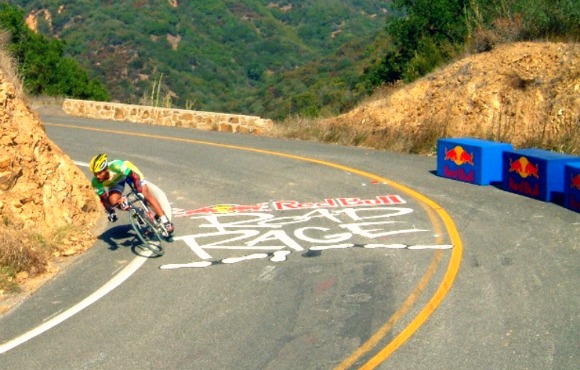Few things in cycling are as blissful as a long, winding descent, but if you want to maximize speed, you need to do more than kick back to admire the scenery. Downhill scorcher and former national criterium champion Antonio Cruz shares his advice on finding the mix of speed, stability, and maneuverability that results in the fastest safe way down.
Find Your Balance
1 of 7
The straight-on downhill stance is, of course, low and aerodynamic: hands on the drops of the handlebar, elbows bent and tucked in, and, if you aren't pedaling, pedals level, knees slightly bent and tucked in, and butt slightly out of the saddle for balance and mobility. You'll need to experiment to find the right front-to-back position for your body. The trick is to notice how subtle shifts in body position affect stability as you descend. When both wheels feel glued to the ground, you've hit the jackpot: this is your basic descending position.
Find
Cycling EventsStop the Cycle
2 of 7
Relaxation is key. Any tension in your body will be transferred to the bike, which creates a vicious cycle, says Cruz. Body stiffness makes the bike harder to control, which makes you even tenser, and makes the bike even harder to control. So, along with bending your knees and elbows, focus on keeping your shoulders relaxed and maintaining a loose grip on the handlebar.
Find
Cycling EventsThink Down the Road
3 of 7
Don't focus on what's happening beside you or directly in front of you, because it's too late to do anything about it anyway. Instead, look at least four or five riders ahead so you have time to react to potholes, gravel or other obstacles. If you're not riding in a pack, just remember that the faster you're descending, the farther ahead you should look. A good basic rule is to "double down"—if you're going 25 mph, look 50 feet down the road. Along with this anticipation comes one of the hardest lessons for any would-be high-speed descender to learn: use the brakes less. Look far enough ahead, and you could avoid trouble without resorting to braking
Find
Cycling EventsWork the Corners
4 of 7
"A lot of people will dive into a turn full throttle, and then scrub speed as they exit," explains Cruz, "but that's the opposite of what you want to do." For a demonstration of efficient cornering, Cruz recommends watching a MotoGP motorcyle race the next time you're channel surfing. Moto racers start wide and sit up to slow down before entering the turn, then get down on the bike and lean hard into the corner, and accelerate out of the turn as the bike comes upright. Keep that "slow early, exit fast" image in mind on your next descent. Plant your weight on your outside pedal to keep control as you lean the bike through the arc, and you'll be carving turns in no time.
Find
Cycling EventsPush It
5 of 7
"Riding at your limit is a sure way to improve," says Cruz, who suggests trying to hang with riders who are better descenders than you are. Remember, though, that you want them to push you to the edge, not over it. If you start to feel uncomfortable, back off by sitting up slightly or lifting your head to let wind resistance slow you down.
Find
Cycling EventsPlay It Smart
6 of 7
Always descend according to the situation. If you're off the front of a group and want to stay there, or you're off the back and trying to catch back up, get into a tuck on straight descents, and pedal hard out of corners for more speed. If you're in a group, don't make sudden or unpredictable moves to gain minor bursts of speed—it's not worth risking the safety of everyone else. And if you're in the middle of a three-hour solo spin or totally blown from the effort of your ride, don't try to pin it. Instead, study the downhill for another day.


Discuss This Article